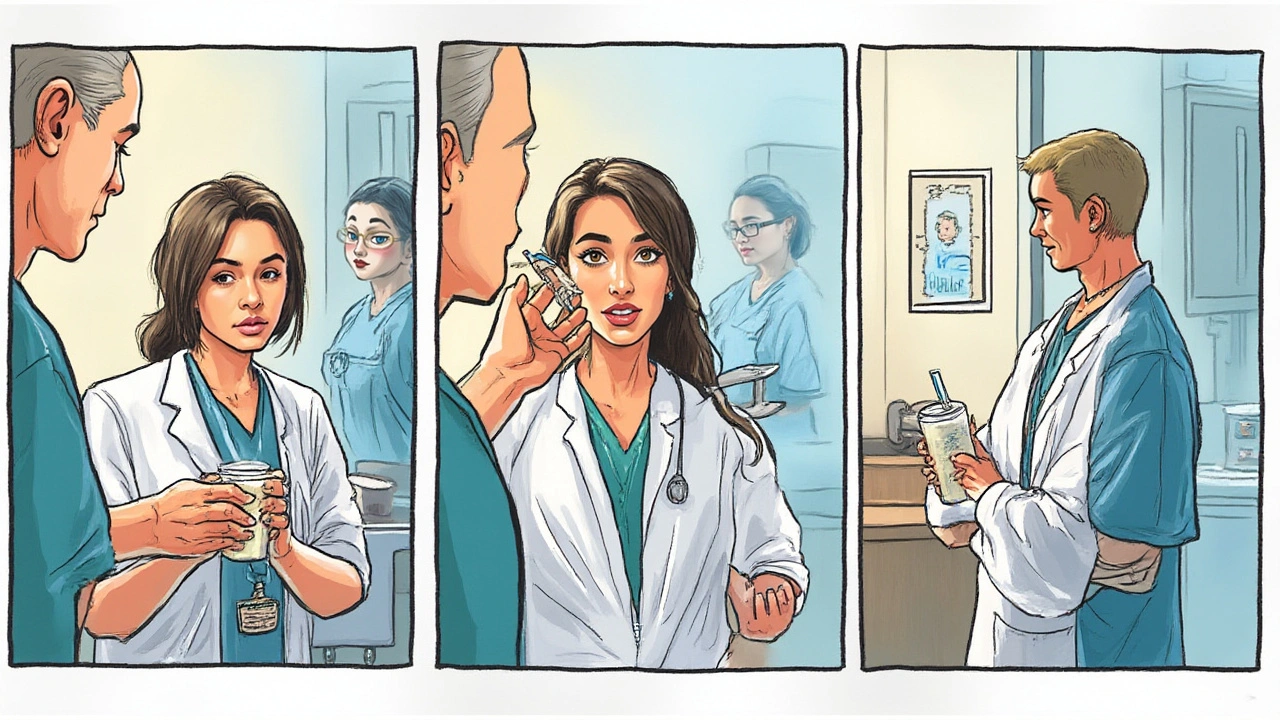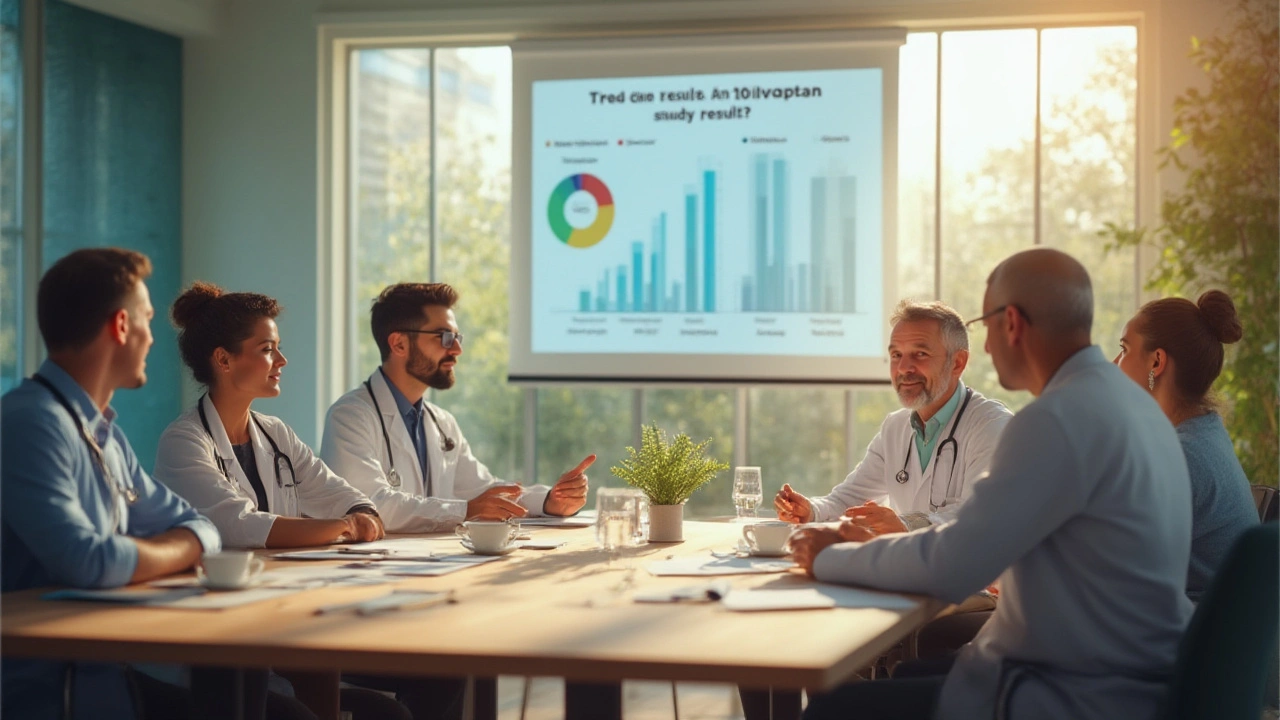Back in 2014, the U.S. FDA approved Tolvaptan for a rare kidney disease, autosomal dominant polycystic kidney disease (ADPKD). What they didn’t mention was the kind of wild ride real patients and doctors would face. Tolvaptan promised to slow kidney cyst growth and dial down that slow crawl towards dialysis. But—like a lot of breakthrough drugs—the reality has been a mix: life-changer for some, headache for others. Fast-forward to today, and we’ve got a much fatter playbook, dozens of stories, and a stronger sense of what Tolvaptan can really do in practice… and where it can backfire.
Tolvaptan’s Clinical Background: How the Drug Caught Fire
A decade ago, treating ADPKD—or persistent low sodium (hyponatremia)—felt like dumping a glass of water on a five-alarm blaze. Kidney cysts grew unchecked, and nothing did much to slow that train. Tolvaptan flipped the script. At its core, tolvaptan is a vasopressin V2-receptor blocker. It’s not just a tongue-twister—that means it targets the hormone responsible for water reabsorption in your kidneys. Block that, and your body stops holding onto excess water, which helps in both ADPKD and certain cases of hyponatremia.
It all started with the TEMPO 3:4 trial. Over 1,400 people with ADPKD took part, chugged Tolvaptan or received a placebo, and went under the scanner for 3 years. Those on Tolvaptan saw their kidney size grow slower by about 49% compared to placebo, and their kidney function held up noticeably better. That was big news, rare for any treatment in kidney medicine. It soon got a reputation—particularly for early to mid-stage ADPKD patients. Doctors in several countries now reach for it when other options are meager.
Then there’s chronic hyponatremia, often in hospitalized patients. Up until Tolvaptan, most fixes—like fluid restriction—were clumsy at best. Small studies since 2011 have shown Tolvaptan pumping sodium levels back up where traditional strategies failed. But as with any drug, nothing’s ever as easy as it sounds in pharma brochures.
Tolvaptan now sits on specific treatment guidelines for both ADPKD and certain types of hyponatremia. Usage has spread across America, Europe, and Asia, and its popularity fueled a wave of copycat drugs. Still, doctors keep one eye warily on side effects and monitoring requirements—Tolvaptan’s not an everyday blood pressure pill. Let’s check the real-world stories, numbers, and workarounds.
Real-World Experiences: What Clinicians & Patients Actually See
Clinical trials are good at filtering out the messy stuff. In daily practice? You see it all. For every patient who soaks up the benefits of Tolvaptan, there’s another who bumps up against its side effects or quirky logistics.
First up: thirst. The most common complaint is relentless, dry-mouth, I-need-to-carry-a-water-bottle-at-all-times thirst. More than 55% of ADPKD patients in the real world reported excessive urination and thirst, especially within the first month. Some people needed to drink 5 liters of water a day just to keep up. That can throw off folks with active jobs, or anyone not able to zoom to a bathroom on demand. For them, the day-to-day cost is real.
Liver function changes are where things get serious. Tolvaptan carries a black-box warning. About 4% of patients in ongoing registries showed hints of liver trouble, and less than 1% saw a jump big enough to stop therapy. Most liver enzyme spikes reverse if you catch them quickly—so regular monitoring is key. The newer RECIST registry out of Europe tracked over 1,000 patients and saw improved detection and safety: almost everyone who had liver values rise saw recovery after stopping or reducing the dose.
Then there’s the personal side. Patients share stories about their first year on Tolvaptan like veterans. Some say it gave them breathing room—no more counting the days until dialysis. Others hated how their social lives screeched when frequent bathroom runs ruled everything, or when their insurance company challenged the cost (Tolvaptan can run six figures a year before help kicks in).
Real-world ADPKD clinics have gotten creative. For patients struggling with thirst, some nephrologists pace up Tolvaptan doses more slowly, starting with the lowest possible dose and stretching it upward over weeks. Nurse educators help folks balance fluids at work, before bed, or while traveling. Copay support programs have improved but still depend on location, and prior authorization can drag on for weeks. The best clinics have staff dedicated to coaching patients through the maze—not just handing over a pill bottle.
For hyponatremia—especially SIADH (syndrome of inappropriate antidiuretic hormone), doctors see fast results. Within 24–48 hours, blood sodium rises. But quick is not always good. Raise sodium too fast, and you risk brain complications, so hospital teams titrate doses cautiously. The sweet spot is a gradual correction: enough to push sodium back to safe levels, not enough to send the body into overdrive. Most clinicians pause Tolvaptan once blood sodium’s stable, since it works so well its effects can overshoot if unsupervised.
Here’s a table with some key numbers from both trials and registries:
| Measure | Tolvaptan | Placebo/Standard Care |
|---|---|---|
| ADPKD—Slowed kidney volume growth | 49% slower | - |
| Avg. eGFR reduction (ml/min/yr, ADPKD, 3 years) | 2.61 | 3.81 |
| Liver enzyme spikes (ALT>3x) | 4.3% | 1.2% |
| Thirst/excess urination | 54–63% | 7–11% |
| Saldo sodium corrected (SIADH, avg. in 3 days) | +6.8 mmol/L | +1.8 mmol/L |

Case Studies: Where Tolvaptan Makes the Difference
No stat sheet tells you what it’s like to break the news to a 34-year-old dad that he’s probably staring down dialysis before 50... unless you bring in something new. Case studies put flesh on those numbers. Let’s get into a couple real-life scenarios that stick with you.
Sarah, 41, got her ADPKD diagnosis after her older sister went onto home dialysis. No symptoms, just anxious scans. Her first year on Tolvaptan went by with a constant need for the nearest restroom and a massive refillable water jug. A year and a half in, her scans showed cyst growth had slowed dramatically. That gave her a psychological win—knowing she had some power over a disease that always felt one step ahead. With support from her nephrology team, she learned time-of-day dose strategies so her workday wasn’t derailed by constant bathroom breaks.
John, 69, was hospitalized for pneumonia, and routine labs turned up sodium at 119 mmol/L—dangerously low. Usual tricks, like restricting his water intake, flopped. One dose of Tolvaptan bumped his sodium up nicely within 24 hours. The medical staff went slow, monitoring every four hours, and never needed to repeat the dose. He was back home two days later, with a pep talk and strict instructions never to self-dose (docs have seen hyponatremia overshoot repairs when people get overzealous with these meds).
Maria’s case sits at a tough intersection—borderline liver enzymes, borderline kidney function. Her nephrologist weighed the risk, set her up for extra-frequent blood checks, and started at the lightest dose. Every two weeks, she and her team checked in. Six months in, her liver tests were steady. Her kidney function (GFR) plateaued for the first time in years. That sense of pause mattered to her, even if the future is still uncertain. Every time she hears about a new ADPKD treatment in the pipeline, she stays ready. But for now, Tolvaptan is “doing the job.”
Stories like these come from clinics worldwide, popped up at recent nephrology conferences, and get talked about in online patient groups. Biggest tip? The best results come when Tolvaptan is started before kidneys decline too far (doctors talk about GFR above 30–45 mL/min; below that, it’s less likely to help much). Patient support networks also highlight the importance of honest side effect management and transparent doctor-patient communication—folks are more likely to stick with therapy when they know what’s likely to hit and how to handle it.
Managing Side Effects and Practical Tips
If anything scares people off Tolvaptan, it’s side effects, hassle, and price. Let’s get into how real-world clinics and patients manage all that. There’s a bit of a learning curve, but there are workarounds and best practices that are actually doable outside the idealized world of clinical studies.
Hydration is everything. Start Tolvaptan, and your body just dumps water. Most clinics recommend patients increase their water intake by 2–4 liters a day, especially in the first weeks. Pro tip: Keep a big water jug handy, track bathroom visits, and always keep a plan for long meetings or road trips. Electrolyte drinks aren’t always better—straight water usually does the job. Just don’t go overboard and drive your sodium even lower.
Liver tests are non-negotiable. Most doctors require a test every month for the first 18 months, then every three months after. If there’s even a blip, they’ll retest within a week or two. Having a routine and reminders—some clinics even automate them—has made detection better and helped patients keep their sanity sorting all the appointments.
Itching and dry skin come up, especially later on. Light moisturizers, loose clothing, and good hydration help. For some, spacing out doses after the first month made a difference. Trouble sleeping because of bathroom trips? Docs sometimes recommend moving the second dose earlier in the day, as long as there’s enough time to process the extra fluid before bedtime.
Cost is still a monster. Tolvaptan lists at over $10,000 per month in the U.S. Insurance often needs several rounds of paperwork and documentation. The key is not to go it alone: many specialty pharmacies have patient assistance coordinators, and it’s worth asking your clinic if they have someone who navigates these hoops. Some countries cover all or most of the cost as part of universal healthcare—others are still catching up.
Here are some street-smart tips, straight from patients and nurses:
- Carry a badge or card explaining frequent bathroom use, especially if you travel or attend events.
- Batch your doses: Split them so the heaviest urination happens during times you’re home or near a restroom.
- Keep track of your bloodwork in a notebook or app; don’t assume the clinic always has the latest numbers.
- If you start Tolvaptan in summer, plan for more sweat and more water needs. Travel with water powder packets if you can’t find safe water everywhere.
- Never try to increase the dose on your own, especially after a missed dose—this can spike side effects.

Looking Ahead: What’s Now and Next in Tolvaptan’s Story
There’s no denying Tolvaptan turned the ADPKD world upside down. Still, it isn’t the endgame. A bunch of next-gen therapies are in clinical testing—targeting inflammation, metabolism, even gene silencing. But right now, for folks sitting in real-world clinics facing a future on dialysis, Tolvaptan still matters. Surveys in 2024 from major kidney centers show that about 1 in 5 eligible ADPKD patients are now offered Tolvaptan. Even more are asking about it. Most continue, at least for a couple years, and side effect dropout rates are inching lower as strategies improve.
Doctors are still debating how to pick the perfect patient—the earlier, the better seems to win the day. Monitoring programs are becoming smoother, with better patient tracking apps and alert systems. More research is underway on how to combine Tolvaptan with future drugs, especially for the unlucky group who see little benefit alone.
The success of Tolvaptan with certain high-risk hyponatremia cases has nudged hospitals to tighten their sodium correction protocols, reducing the severe complications caused by overcorrection. Hospital teams using standardized order sets and electronic reminders have almost zeroed out these old pitfalls.
Where does Tolvaptan fit in the toolbox today? It’s a tried and tested—if imperfect—lifeline. You need the right patient, the right timing, careful follow-up, but it’s now more than just a medical curiosity. For those who respond, it can delay kidney failure, buy years of quality time, or snap a stubborn case of hyponatremia out of danger territory. It won’t fix everything, but it’s already changed the stakes for thousands. Maybe not the miracle pill, but in the world of rare kidney medicine, it’s the closest thing many have seen so far.


Comments (12)
Jeremy S. July 5 2025
Tolvaptan is wild. My cousin's been on it for 3 years. Thirsty as hell but no dialysis yet. Worth it.Jill Ann Hays July 6 2025
The pharmacokinetics of vasopressin antagonism in ADPKD represent a paradigm shift in nephrology yet the clinical implementation remains fraught with systemic inefficiencies and patient compliance challengesMike Rothschild July 6 2025
If you're starting Tolvaptan start low go slow. Drink water but don't chug. Track your liver labs. Get a buddy to remind you. It's not magic but it's the best shot most of us have.Ron Prince July 7 2025
this drug is just another big pharma scam. we dont need this fancy science crap. back in my day we just drank less water and toughed it out. now everyone wants a pill for everythingSarah McCabe July 8 2025
I'm Irish and we don't even have access to this here 😅. My cousin in Boston says it's a game changer but the cost? My god. She had to fight her insurance for 6 months. Still worth it though 🙏Kristy Sanchez July 10 2025
Oh so now we're celebrating a drug that turns you into a human water fountain? Congrats. At least your liver gets to be a science experiment too. So romantic.Michael Friend July 11 2025
I knew someone on this. She started bleeding from her gums. Then her liver went haywire. Then she lost her job because she had to pee every 20 minutes. This isn't treatment. It's a slow-motion tragedy dressed in a white coat.Jerrod Davis July 11 2025
The efficacy of tolvaptan in slowing renal volume expansion is statistically significant; however, the concomitant burden of hepatic monitoring and polyuria necessitates a risk-benefit analysis that is not trivially resolved in ambulatory settings.Dominic Fuchs July 13 2025
You ever notice how the people who need this drug the most are the ones who can't afford the paperwork to get it? We're treating kidneys with bureaucracyAsbury (Ash) Taylor July 14 2025
To anyone considering tolvaptan: you're not alone. The thirst is real. The bathroom trips are brutal. But the fact that your kidneys are still working next year? That's worth the grind. Find your support group. Talk to your nurse. You've got this.Kenneth Lewis July 15 2025
i took tolvaptan for 6 months. lost 20 lbs of water weight. had to pee every 30 min. liver tests were fine. but my dog started avoiding me bc i was always in the bathroom lol. still would do it againJim Daly July 17 2025
this drug is overhyped. everyone says its a miracle but my uncle took it and still got dialysis in 2 years. so what was the point? just made him thirsty and broke